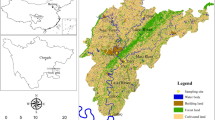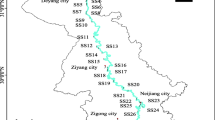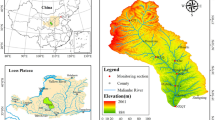Abstract
Anthropogenic activities pose challenges on security of water quality. Identifying potential sources of pollution and quantifying their corresponding contributions are essential for water management and pollution control. In our study, 2-year (2017–2018) water quality dataset of 15 parameters from eight sampling sites in tributaries and mainstream of the Min River was analyzed with multivariate statistical analysis methods and absolute principal component score-multiple linear regression (APCS-MLR) receptor modeling technique to reveal potential sources of pollution and apportion their contributions. Temporal and spatial cluster analysis (CA) classified 12 months into three periods exactly consistent with dry, wet, and normal seasons, and eight monitoring sites into two regions, lightly polluted (LP) and highly polluted (HP) regions, based on different levels of pollution caused by physicochemical properties and anthropogenic activities. The principal component analysis (PCA) identified five latent factors accounting for 75.84% and 73.46% of the total variance in the LP and HP regions, respectively. The main pollution sources in the two regions included agricultural activities, domestic sewage, and industrial wastewater discharge. APCS-MLR results showed that in the LP region, contribution of five potential pollution sources was ranked as agricultural non-point source pollution (22.13%) > seasonal effect and phytoplankton growth (19.86%) > leakage of septic tanks (15.73%) > physicochemical effect (12.86%) > industrial effluents and domestic sewage (11.59%), while in the HP region ranked as point source pollution from domestic and industrial discharges (20.81%) > municipal sewage (16.66%) > agricultural non-point source pollution (15.23%) > phytoplankton growth (14.82%) > natural and seasonal effects (12.67%). Based on the quantitative assessment of main pollution sources, the study can help policymakers to formulate strategies to improve water quality in different regions.







Similar content being viewed by others
References
Carpenter S, Caraco N, Correll D, Howarth RW, Sharpley AN, Smith VH (1998) Nonpoint pollution of surface waters with phosphorus and nitrogen. Ecol Appl 8:559–568
Chaturvedi R, Banerjee S, Das B, Chattopadhyay P, Bhattacharjee CR, Veer V (2016) High nitrate content in the surface water of Balipara, North Brahmaputra river basin, Sonitpur district, Assam, India: a multivariate approach. Curr Sci 110:1350–1360
Chen H, Teng Y, Wang J (2013a) Load estimation and source apportionment of nonpoint source nitrogen and phosphorus based on integrated application of SLURP model, ECM, and RUSLE: a case study in the Jinjiang River, China. Environ Monit Assess 185(2):2009–2021
Chen H, Teng Y, Yue W, Song L (2013b) Characterization and source apportionment of water pollution in Jinjiang River, China. Environ Monit Assess 185:9639–9650
Chen P, Li L, Zhang H (2015) Spatio-temporal variations and source apportionment of water pollution in Danjiangkou Reservoir Basin, Central China. Water 7:2591–2611
Chen R, Teng Y, Chen H, Hu B, Yue W (2019) Groundwater pollution and risk assessment based on source apportionment in a typical cold agricultural region in Northeastern China. Sci Total Environ 696:133972
Duan W, He B, Nover D, Yang G, Chen W, Meng H, Zou S, Liu C (2016) Water quality assessment and pollution source identification of the eastern Poyang Lake Basin using multivariate statistical methods. Sustainability 8:133
Filstrup CT, Downing JA (2017) Relationship of chlorophyll to phosphorus and nitrogen in nutrient-rich lakes. Inland Waters 7:385–400
Filstrup CT, Wagner T, Soranno PA, Stanley EH, Stow CA, Webster KE, Downing JA (2014) Regional variability among nonlinear chlorophyll-phosphorus relationships in lakes. Limnol Oceanogr 59:1691–1703
Gholizadeh MH, Melesse AM, Reddi L (2016) Water quality assessment and apportionment of pollution sources using APCS-MLR and PMF receptor modeling techniques in three major rivers of South Florida. Sci Total Environ 566-567:1552–1567
Han Q, Tong R, Sun W, Zhao Y, Yu J, Wang G, Jin Y (2020) Anthropogenic influences on the water quality of the Baiyangdian Lake in North China over the last decade. Sci Total Environ 701:134929
Huang F, Wang X, Lou L, Zhou Z, Wu J (2010) Spatial variation and source apportionment of water pollution in Qiantang River (China) using statistical techniques. Water Res 44(5):1562–1572
Jabbar FK, Grote K (2019) Statistical assessment of nonpoint source pollution in agricultural watersheds in the lower Grand River watershed, MO, USA. Environ Sci Pollut Res 26(2):1487–1506
Jung KY, Lee K, Im TH, Lee IJ, Kim S, Han K, Ahn JM (2016) Evaluation of water quality for the Nakdong River watershed using multivariate analysis. Environ Technol Innov 5:67–82
Kumar AS, Reddy AM, Srinivas L, Reddy PM (2014) Assessment of surface water quality in Hyderabad Lakes by using multivariate statistical techniques, Hyderabad-India. Environ Pollut 4. https://doi.org/10.5539/ep.v4n2p14
Li Y, Yang Z (2020) Soil nutrients and soul microbial characteristics and their relationship under different land use types in Minjiang River Basin. Res Soil Water Conserv 27(1):33–46 (In Chinese)
Li X, Li P, Wang D, Wang Y (2014) Assessment of temporal and spatial variations in water quality using multivariate statistical methods: a case study of the Xin’anjiang s, China. Front Environ Sci Eng 8:895–904. https://doi.org/10.1007/s11783-014-0736-z
Li Q, Zhang H, Guo S, Fu K, Liao L, Xu Y, Cheng S (2019) Groundwater pollution source apportionment using principal component analysis in a multiple land-use area in southwestern China. Environ Sci Pollut Res 27:9000–9011. https://doi.org/10.1007/s11356-019-06126-6
Liu C, Lin K, Kuo Y (2003) Application of factor analysis in the assessment of groundwater quality in a Blackfoot disease area in Taiwan. Sci Total Environ 313:77–89
Liu L, Dong Y, Kong M, Zhou J, Zhao H, Tang Z, Wang Z (2019a) Insights into the long-term pollution trends and sources contributions in Lake Taihu, China using multi-statistic analyses models. Chemosphere 242:125272
Liu L, Tang Z, Kong M, Chen X, Zhou C, Huang K, Wang Z (2019b) Tracing the potential pollution sources of the coastal water in Hong Kong with statistical models combining APCS-MLR. J Environ Manag 245:143–150
López-Alonso M, Rey-Crespo F, Herrero-Latorre C, Miranda M (2017) Identifying sources of metal exposure in organic and conventional dairy farming. Chemosphere 185:1048–1055
MEEC (2002) Technical specifications requirements for monitoring of surface water and waste water (HJ/T 91-2002). Ministry of Ecology and Environment of the People’s Republic of China, Beijing
MEPC (2002) Environmental quality standards for surface water, GB 3838-2002. Ministry of Environmental Protection of China, Beijin (In Chinese)
MSB (2018) Meishan statistical yearbook 2018, Meishan Statistics Bureau (In Chinese)
Muangthong S, Shrestha S (2015) Assessment of surface water quality using multivariate statistical techniques: case study of the Nampong River and Songkhram River, Thailand. Environ Monit Assess 187:548
MWRPRC (2019) China water resource bulletin 2018. Ministry of Water Resources of the People’s Republic of China Beijing 1–8 (in Chinese)
Najar IA, Khan AB (2011) Assessment of water quality and identification of pollution sources of three lakes in Kashmir, India, using multivariate analysis. Environ Earth Sci 66(8):2367–2378
Ouyang Y, Nkedi-Kizza P, Wu QT, Shinde D, Huang CH (2006) Assessment of seasonal variations in surface water quality. Water Res 40:3800–3810
Pérez-Gutiérrez JD, Paz JO, Tagert MLM (2017) Seasonal water quality changes in on-farm water storage systems in a south-central U.S. agricultural watershed. Agric Water Manag 187:131–139
Ren C, Wang L, Zheng B, Qian J, Ton H (2016) Ten-year change of total phosphorous pollution in the Min River, an upstream tributary of the three gorges reservoir. Environ Earth Sci 75:1015
Schaefer K, Einax JW (2010) Analytical and chemometric characterization of the Cruces River in South Chile. Environ Sci Pollut Res 17:115–123
Sener S, Sener E, Davraz A (2017) Evaluation of water quality using water quality index (WQI) method and GIS in Aksu River (SW-Turkey). Sci Total Environ 584-585:131–144
Shrestha S, Kazama F (2007) Assessment of surface water quality using multivariate statistical techniques: a case study of the Fuji river basin, Japan. Environ Model Softw 22:464–475
SIEPS (2017) Water standard scheme of Minjiang Yuelai ferry control unit in Meishan City Sichuan. Institute of Environmental Protection Science, Chengdu (In Chinese)
Su S, Li D, Zhang Q, Xiao R, Huang F, Wu J (2011) Temporal trend and source apportionment of water pollution in different functional zones of Qiantang River, China. Water Res 45:1781–1795
Thurston GD, Spengler JD (1985) A quantitative assessment of source contributions to inhalable particulate matter pollution in metropolitan. Boston Atmos Environ 19(1):9–25
Varol M (2020) Spatio-temporal changes in surface water quality and sediment phosphorus content of a large reservoir in Turkey. Environ Pollut 259:113860
Varol M, Gökot B, Bekleyen A, Şen B (2012) Spatial and temporal variations in surface water quality of the dam reservoirs in the Tigris River basin, Turkey. Catena 92:11–21
Verheyen D, Van Gaelen N, Ronchi B, Batelaan O, Struyf E, Govers G, Merckx R, Diels J (2015) Dissolved phosphorus transport from soil to surface water in catchments with different land use. Ambio 44:228–240
Wang Y, Wang P, Bai Y, Tian Z, Li J, Shao X, Li BL (2013) Assessment of surface water quality via multivariate statistical techniques: a case study of the Songhua River Harbin region, China. J Hydro Environ Res 7:30–40
Wang H, An J, Cheng M, Shen L, Zhu B, Li Y, Wang Y, Duan Q, Sullivan A, Xia L (2016) One year online measurements of water-soluble ions at the industrially polluted town of Nanjing, China: sources, seasonal and diurnal variations. Chemosphere 148:526–536
Williams B, Onsman A, Brown T (2010) Exploratory factor analysis: a five-step guide for novices. J Emerg Prim Health Care 8(3):1–13
Xiao M, Bao F, Wang S, Cui F (2016) Water quality assessment of the Huaihe River segment of Bengbu (China) using multivariate statistical techniques. Water Res 43:166–176
Zamparas M, Zacharias I (2014) Restoration of eutrophic freshwater by managing internal nutrient loads. A review. Sci Total Environ 496:551–562
Zanotti C, Rotiroti M, Fumagalli L, Stefania GA, Canonaco F, Stefenelli G, Prévôt ASH, Leoni B, Bonomi T (2019) Groundwater and surface water quality characterization through positive matrix factorization combined with GIS approach. Water Res 159:122–134
Zeinalzadeh K, Rezaei E (2017) Determining spatial and temporal changes of surface water quality using principal component analysis. J Hydrol Reg Stud 13:1–10
Zhang R (2017) Evaluation of soil environmental quality in key areas of Meishan. Shandong Chem Ind 46(10):208–210 (In Chinese)
Zhang G, Ding S, Chen Q (2008) Analysis of soil erosion of different land use types in Meishan city. Soil Water Conserv China 10:41–43 (In Chinese)
Zhang Y, Guo F, Meng W, Wang X (2009) Water quality assessment and source identification of Daliao river basin using multivariate statistical methods. Environ Monit Assess 152:105–121
Zhang Z, Tao F, Du J, Shi P, Yu D, Meng Y, Sun Y (2010) Surface water quality and its control in a river with intensive human impacts-a case study of the Xiangjiang River, China. J Environ Manag 91:2483–2490
Zhang Q, Wang H, Wang Y, Yang M, Zhu L (2017) Groundwater quality assessment and pollution source apportionment in an intensely exploited region of northern China. Environ Sci Pollut Res 24:16639–16650
Zhang H, Xu Y, Cheng SQ, Li QL, Yu HR (2020) Application of the dual-isotope approach and Bayesian isotope mixing model to identify nitrate in groundwater of a multiple land-use area in Chengdu Plain, China. Sci Total Environ 717:137134. https://doi.org/10.1016/j.scitotenv.2020.137134
Zhao J, Xu Z, Liu X, Niu C (2013) Source apportionment in the Liao River basin. China Environ Sci 5:13
Zhao J, Fu G, Lei K (2015) Water quality assessment and apportionment of pollution sources of selected pollutants in the min Jiang, a headwater tributary of the Yangtze River. Hydrol Curr Res 6(3):1–7
Zheng L, Yu H, Wang Q (2015) Assessment of temporal and spatial variations in surface water quality using multivariate statistical techniques: a case study of Nenjiang River basin, China. J Cent South Univ 22(10):3770–3780
Zhong M, Zhang H, Sun W, Wang Z, Tian W, Huang H (2018) Analyzing the significant environmental factors on the spatial and temporal distribution of water quality utilizing multivariate statistical techniques: a case study in the Balihe Lake, China. Environ Sci Pollut Res 25:29418–29432
Zhou F, Huang G, Guo H, Zhang W, Hao Z (2007) Spatio–temporal patterns and source apportionment of coastal water pollution in eastern Hong Kong. Water Res 41(15):3429–3439
Funding
This study is supported by the National Natural Science Foundation of China (Grant no. 51979237) and Sichuan Province Science and Technology Support Program, China (Grant no. 2019YJ0234).
Author information
Authors and Affiliations
Corresponding author
Additional information
Responsible Editor: Xianliang Yi
Publisher’s note
Springer Nature remains neutral with regard to jurisdictional claims in published maps and institutional affiliations.
Rights and permissions
About this article
Cite this article
Zhang, H., Li, H., Yu, H. et al. Water quality assessment and pollution source apportionment using multi-statistic and APCS-MLR modeling techniques in Min River Basin, China. Environ Sci Pollut Res 27, 41987–42000 (2020). https://doi.org/10.1007/s11356-020-10219-y
Received:
Accepted:
Published:
Issue Date:
DOI: https://doi.org/10.1007/s11356-020-10219-y




